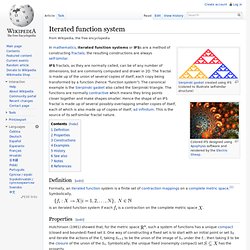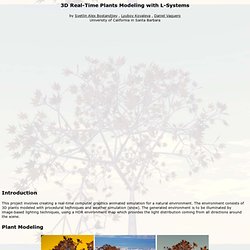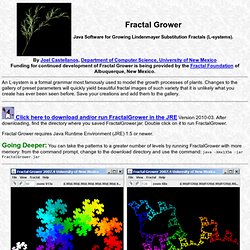

Www.cse.chalmers.se/~uffe/xjobb/climbingplants. Www.upv.es/upl/U0431760.pdf. 3D Lindenmayer Systems. 3D L-System Buildings - Madina Berkaliyeva Game Developer. Iterated function system. In mathematics, iterated function systems or IFSs are a method of constructing fractals; the resulting constructions are always self-similar.

IFS fractals, as they are normally called, can be of any number of dimensions, but are commonly computed and drawn in 2D. The fractal is made up of the union of several copies of itself, each copy being transformed by a function (hence "function system"). The canonical example is the Sierpinski gasket also called the Sierpinski triangle. The functions are normally contractive which means they bring points closer together and make shapes smaller. Www.jcourtois.fr/uploads/report/Rapport_Grammaire_L_System.pdf?symfony=03610758189d2404b63451e1dedcf8d2. OpenGL L-System Rendering. 3D Real-Time Plants Modeling with L-Systems. 3D Real-Time Plants Modeling with L-Systems by Svetlin Alex Bostandjiev , Lyubov Kovaleva , Daniel Vaquero University of California in Santa Barbara Introduction This project involves creating a real-time computer graphics animated simulation for a natural environment.

The environment consists of 3D plants modeled with procedural techniques and weather simulation (snow). The generated environment is to be illuminated by image-based lighting techniques, using a HDR environment map which provides the light distribution coming from all directions around the scene. Plant Modeling (click on images to enlarge) We use Lindenmayer systems (L-systems) for the modeling of 3D plants, such as, trees, bushes, and weeds. G = {V, S, w, P} where,
Tutorials.html. On this page you will find tutorials which show you how to program different graphical effects related to nature.

In the starting period, the programs will be in C++ for the windows platform. To make it easier to transfer them to other platforms they will use Opengl (maybe some of them will use the glut library). In the long run, the tutorials will be translated to Delphi, Kylix, Visual Studio and other platforms - mainly Linux. If you have written a cool program and would like to share your knowledge with fellow programmers, please send in your program/tutorial :-) Currently the following topics are planed: L-System > Home. Fractal Grower (home) By Joel Castellanos, Department of Computer Science, University of New Mexico Funding for continued development of Fractal Grower is being provided by the Fractal Foundation of Albuquerque, New Mexico.

An L-system is a formal grammar most famously used to model the growth processes of plants. Changes to the gallery of preset parameters will quickly yield beautiful fractal images of such variety that it is unlikely what you create has ever been seen before. Save your creations and add them to the gallery. Click here to download and/or run FractalGrower in the JRE Version 2010-03.
After downloading, find the directory where you saved FractalGrower.jar. Fractal Grower requires Java Runtime Environment (JRE) 1.5 or newer. You can take the patterns to a greater number of levels by running FractalGrower with more memory: from the command prompt, change to the download directory and use the command: java -Xmx135m -jar FractalGrower.jar. L-System Plant Geometry Generator. By Hung-Wen Chen hwchen@cs.cornell.edu JAN, 1995.

EDT Figure 1. 3D-1 brcketed OL-system tree For more pictures. Click Here. Algorithmic Botany: Publications. Procedural generation: A vegetation scattering tool for Unity3D, Part I. After spending some days in Blender and Unity3D trying to do a level for a puzzle game I am working on, I realized (as I knew in theory) how painful it is to make vegetation by placing, rotating and scaling items in the scene one by one.

Specifically I wanted to place dense vegetation along the borders of my level to create the illusion of a vast and dark forest surrounding the level, explaining in a way why the player is stuck in that place. So I created a tree and some grass in blender, nothing fancy, and started placing them on my scene. After a couple of hours I was done and the result looked pretty nice, but then I realized that there were things I did not like and had to tweak them. Plant Generation - Procedural Content Generation Wiki. Generating Trees and other Vegetation procedurally. I think you should try it, optimize it as much as you can, and if it works,keep it.As far as spacial complexity goes, I don't think you have to worry about that, most computers have enough memory for games to hog.Also let's think for a moment, let's say that every tree is made through a level 5 recursion.

Then you'll have 1+a+a^2+... +a^5 nodes (which I presume are actually points in space) where a is the number of branches you use to make the tree which again I presume is on average 3.That's (1-3^6)/(1-3) nodes = 364 nodes per tree. But each node is actually a point, which in turn is made out of two floats that take up 32 bits in memory, so each node takes up 64 bits.So each tree would take up 364 * 64 = 23,296 bits in memory, that's roughly 23 kB. Flash Bestiary: A compendium of actionscript code. Virtual Terrain Project.